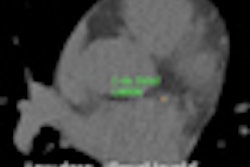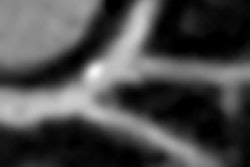VIENNA - There's no reason to limit the use of coronary CT angiography (CCTA) in patients with high calcium scores -- as long as the scanner is 64-detector-rows or higher, according to a new meta-analysis of 27 studies presented on Friday at the European Congress of Radiology (ECR).
The analysis of more than 5,000 patients undergoing CCTA on various scanner models concluded that sensitivity and specificity were not substantially diminished in patients with even severe calcifications, calling into question limitations on the use of the modality in patients with suspected coronary artery disease (CAD) who have a high calcium burden.
CCTA has shown consistently high sensitivity and specificity for detecting coronary artery stenosis, but coronary calcium can limit lumen assessment due to blooming artifacts, said Dr. Martijn den Dekker from Groningen University in the Netherlands in his presentation on Friday. For this reason, some centers maintain a calcium score cutoff level above which CCTA is not performed. But is this limitation still applicable?
"Over the years, CT has improved considerably with increased spatial and temporal resolution, and whether a calcium score cutoff is still needed for performing coronary CTA is questionable," said Dekker.
To make this surprising assessment, Dekker and his colleagues set out to review the cutoff levels used in literature, and then evaluated the diagnostic performance of CCTA in patients from multiple studies with a variety of calcium score levels on several different scanner types.
The study team performed a systematic review and meta-analysis to assess sensitivity and specificity of CCTA for significant stenosis at different degrees of coronary calcification. A literature search helped them identify studies describing the test characteristics of CCTA for significant stenosis that were performed with a variety of scanners from minimal 16 to 320 detector rows. Invasive coronary angiography in all patients served as the reference standard for the retrospective analysis, and the group then evaluated the pooled sensitivity and specificity of CCTA on different scanner categories and generations. The analysis was performed both on a per-patient and a per-segment basis, Dekker said.
"The most frequently used calcium score cutoff was 400, but the cutoff ranged from around 100 to 1,000. Based on the degree of diagnostic accuracy, the risk of nondiagnostic exams, and the prevalence of known coronary artery disease, the [receiver operator characteristics (ROC)] curves all varied per scanner generation," he said. Studies included in the meta-analysis were chosen because they reported the test characteristics by CTA by calcium score category, and because they used invasive coronary CTA to validate the results.
Twenty-seven of the 51 studies in the systematic review were subsequently included in the meta-analysis, representing 5,203 patients (mean age, 63; 67% male) with a mean calcium score of 220 (range, 0-8,420). Findings included the following:
- More than three-fourths of the patients were scanned for typical chest pain or for suspected coronary artery disease (36% typical chest pain; 27% suspected CAD; 13% atypical chest pain; 15% unstable angina or non-ST-wave myocardial infarction; 6% preoperative screening; and 3% asymptomatic).
Among the 21 studies that analyzed a total of 4,504 patients, three were performed with 16-detector-row MDCT, 12 with 64-detector-row MDCT, five with dual-source CT (DSCT), and one with 320-detector-row MDCT.
Patient-based results by calcium score
|
The specificity of CCTA was significantly lower for patients with calcium scores between 401 and 1,000 for all measures due to lack of patients without significant stenosis in this subgroup, Dekker said; notably, specificity was not lower overall in patients with a calcium score greater than 1,000. More than 83% of segments were included; the main reasons segments were excluded involved motion artifacts or small vessel size, "and only six studies excluded segments due to heavy calcifications," he noted. The pooled sensitivity was 96.9%, and the pooled specificity was 86.4%, Dekker said.
"On a per-patient basis, we see significantly lower specificity for 16-row MDCT," he said, "while 64-row and newer scanner generations have significantly improved sensitivity and specificity."
Patient-based results per scanner generation
|
Segment-based results per scanner generation
|
"There is considerable heterogeneity in calcium score cutoffs on the decision whether or not to perform coronary CTA," he said. "And in 64-row MDCT and newer scanner generations, the sensitivity and specificity of coronary CTA remain high even in the case of severe coronary calcifications, and a calcium score cutoff may not be needed anymore when using 64-row CT and newer scanner generations."
Session moderator Dr. N.E. Klow from Oslo questioned Dekker's results. "It's very nice work but I'm surprised about the conclusion. In my work it's still hard to evaluate heavily calcified lesions," he said. "Why do you think there's a difference between daily practice and all these studies?"
"In clinical practice we do see that heavily calcified lesions can be assessed, although many times it will need more postprocessing before it can be assessed well," Dekker responded. "Noncalcified or mixed plaques are more easily assessable than heavily calcified ones, so you might need a different [reconstruction] kernel, or postprocessing."




















